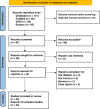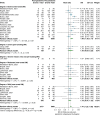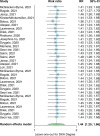Incidence of diabetic ketoacidosis during COVID-19 pandemic: a meta-analysis of 124,597 children with diabetes
- PMID: 35953513
- PMCID: PMC9366798
- DOI: 10.1038/s41390-022-02241-2
Incidence of diabetic ketoacidosis during COVID-19 pandemic: a meta-analysis of 124,597 children with diabetes
Abstract
Background: Diabetic ketoacidosis (DKA) is a potentially life-threatening complication of type 1 diabetes mellitus (T1DM) that has increased during the COVID-19 pandemic. This study will not only shed light on such life-threatening complications but also be a step to increase the awareness of healthcare providers about such complications in the upcoming pandemic waves and increased dependence on telemedicine. Thus, we aimed to further investigate the increase of DKA in pediatrics.
Methods: PubMed, Web of Science, and Scopus were broadly searched for studies assessing the incidence of DKA in pediatrics during the COVID-19 pandemic.
Results: Our study included 24 papers with a total of 124,597 children with diabetes. A statistically significant increase occurred in the risk of DKA among newly diagnosed T1DM patients during the pandemic (RR 1.41; 95% CI 1.19, 1.67; p < 0.01; I2 = 86%), especially in the severe form of DKA (RR 1.66: 95% CI 1.3, 2.11) when compared to before.
Conclusion: DKA in newly diagnosed children with T1DM has increased during the pandemic and presented with a severe form. This may reflect that COVID-19 may have contributed not only to the development but also the severity of DKA.
Impact: Diabetic ketoacidosis (DKA) is a life-threatening complication of type 1 diabetes mellitus (T1DM) that has increased during the COVID-19 pandemic. Our study included 25 papers with a total of 124,597 children with diabetes. A statistically significant increase occurred in the risk of DKA among newly diagnosed T1DM patients during the pandemic. Our findings reflect that COVID-19 may have an altered presentation in T1DM and can be related to DKA severity.
© 2022. The Author(s), under exclusive licence to the International Pediatric Research Foundation, Inc.
Conflict of interest statement
The authors declare no competing interests.
Figures






Similar articles
-
Impact of the COVID-19 pandemic on the incidence and clinical outcomes of diabetic ketoacidosis among male and female children with type 1 diabetes: systematic review and meta-analysis.F1000Res. 2023 Aug 10;12:72. doi: 10.12688/f1000research.128687.2. eCollection 2023. F1000Res. 2023. PMID: 39262444 Free PMC article.
-
Incidence of Diabetic Ketoacidosis Among Pediatrics With Type 1 Diabetes Prior to and During COVID-19 Pandemic: A Meta-Analysis of Observational Studies.Front Endocrinol (Lausanne). 2022 Mar 9;13:856958. doi: 10.3389/fendo.2022.856958. eCollection 2022. Front Endocrinol (Lausanne). 2022. PMID: 35355556 Free PMC article.
-
Incidence of Type 1 Diabetes Mellitus and Characteristics of Diabetic Ketoacidosis in Children and Adolescents during the First Two Years of the COVID-19 Pandemic in Vojvodina.Medicina (Kaunas). 2022 Jul 28;58(8):1013. doi: 10.3390/medicina58081013. Medicina (Kaunas). 2022. PMID: 36013479 Free PMC article.
-
Increased Severity of Presentation Signs in Children with Newly Diagnosed Type 1 Diabetes during the COVID-19 Pandemic: A Tertiary Center Experience.Ann Nutr Metab. 2024;80(3):161-170. doi: 10.1159/000538322. Epub 2024 Mar 13. Ann Nutr Metab. 2024. PMID: 38479369
-
The Effect of the SARS-CoV-2 Pandemic on Presentation with Diabetic Ketoacidosis in Children with New Onset Type 1 Diabetes Mellitus.J Clin Res Pediatr Endocrinol. 2023 Aug 23;15(3):264-267. doi: 10.4274/jcrpe.galenos.2023.2022-11-4. Epub 2023 Mar 29. J Clin Res Pediatr Endocrinol. 2023. PMID: 36987789 Free PMC article.
Cited by
-
Impact of the COVID-19 pandemic on the incidence and clinical outcomes of diabetic ketoacidosis among male and female children with type 1 diabetes: systematic review and meta-analysis.F1000Res. 2023 Aug 10;12:72. doi: 10.12688/f1000research.128687.2. eCollection 2023. F1000Res. 2023. PMID: 39262444 Free PMC article.
-
The Relationship Between COVID-19 and the Development of Diabetic Ketoacidosis and New-Onset Type 1 Diabetes Mellitus.Cureus. 2024 May 20;16(5):e60711. doi: 10.7759/cureus.60711. eCollection 2024 May. Cureus. 2024. PMID: 38903308 Free PMC article.
-
Electrospun Fibrous Nanocomposite Sensing Materials for Monitoring Biomarkers in Exhaled Breath.Polymers (Basel). 2023 Apr 10;15(8):1833. doi: 10.3390/polym15081833. Polymers (Basel). 2023. PMID: 37111980 Free PMC article.
-
Pediatric Diabetic Ketoacidosis (PDKA) among newly diagnosed diabetic patients at Dilla University Hospital, Dilla, Ethiopia: Prevalence and predictors.PLoS One. 2025 Jan 30;20(1):e0314433. doi: 10.1371/journal.pone.0314433. eCollection 2025. PLoS One. 2025. PMID: 39883619 Free PMC article.
-
An exploratory analysis of the impact of the COVID-19 pandemic on pediatric type 1 diabetes mellitus patient outcomes: A single-center study.Front Pediatr. 2022 Nov 18;10:1038345. doi: 10.3389/fped.2022.1038345. eCollection 2022. Front Pediatr. 2022. PMID: 36467474 Free PMC article.
References
-
- Mohamed S, et al. Is COVID-19 a systemic disease? Coronaviruses. 2021;2:e060521189167.
Publication types
MeSH terms
LinkOut - more resources
Full Text Sources
Medical

